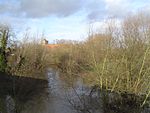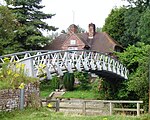Brightwell Castle
Castles in BerkshireEngland castle stubsSouth Oxfordshire District
Brightwell Castle was in the village of Brightwell-cum-Sotwell, between the towns of Didcot and Wallingford (grid reference SU578908), now in Oxfordshire but until 1974 in Berkshire, in England. The castle was built in 1145 by King Stephen. At the time there was civil war known as The Anarchy between King Stephen and his cousin Empress Matilda, whose headquarters were at nearby Wallingford Castle. In 1153 the castle was destroyed by Matilda's son, who later became Henry II. A manor house now stands on the site.
Excerpt from the Wikipedia article Brightwell Castle (License: CC BY-SA 3.0, Authors).Brightwell Castle
Brightwell Street, South Oxfordshire Brightwell-cum-Sotwell
Geographical coordinates (GPS) Address Nearby Places Show on map
Geographical coordinates (GPS)
| Latitude | Longitude |
|---|---|
| N 51.61307 ° | E -1.16665 ° |
Address
Saint Agatha
Brightwell Street
OX10 0SB South Oxfordshire, Brightwell-cum-Sotwell
England, United Kingdom
Open on Google Maps










